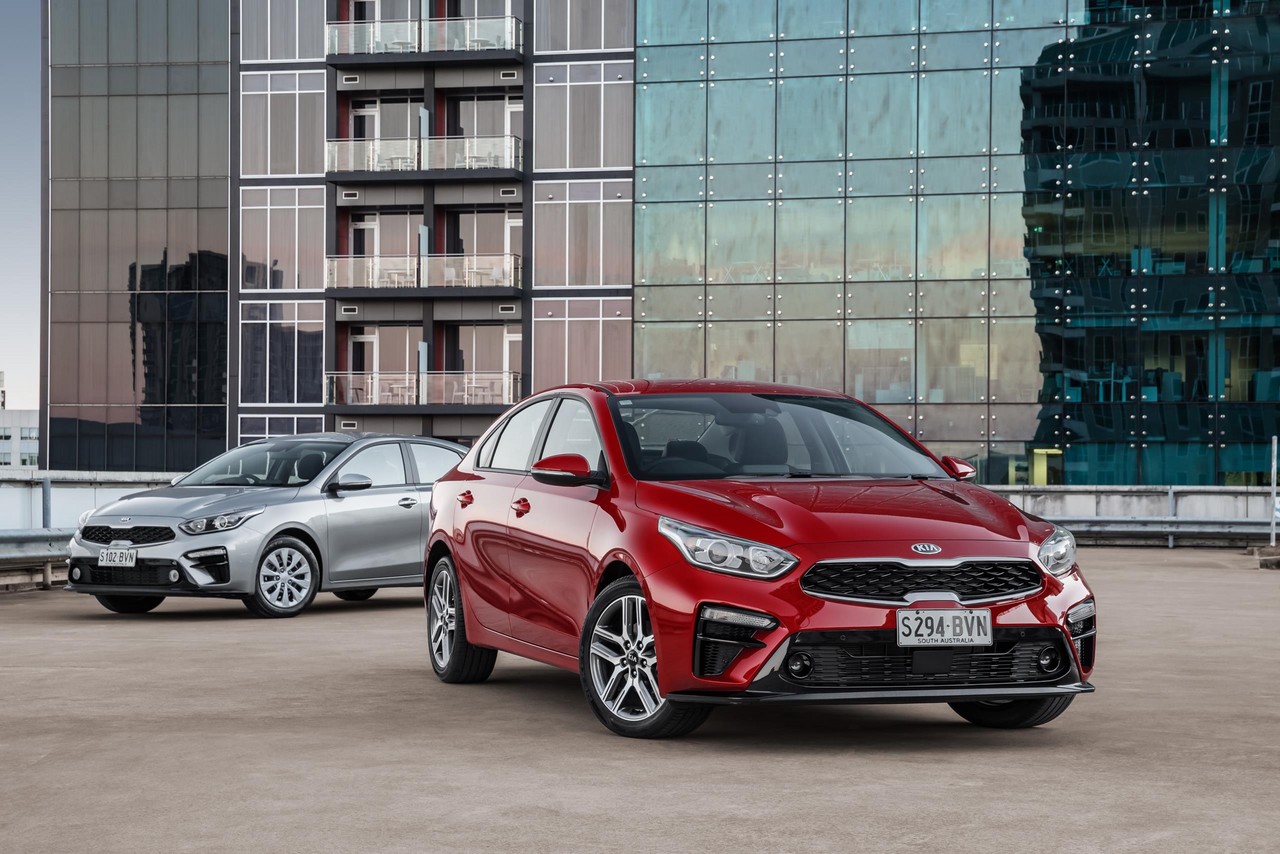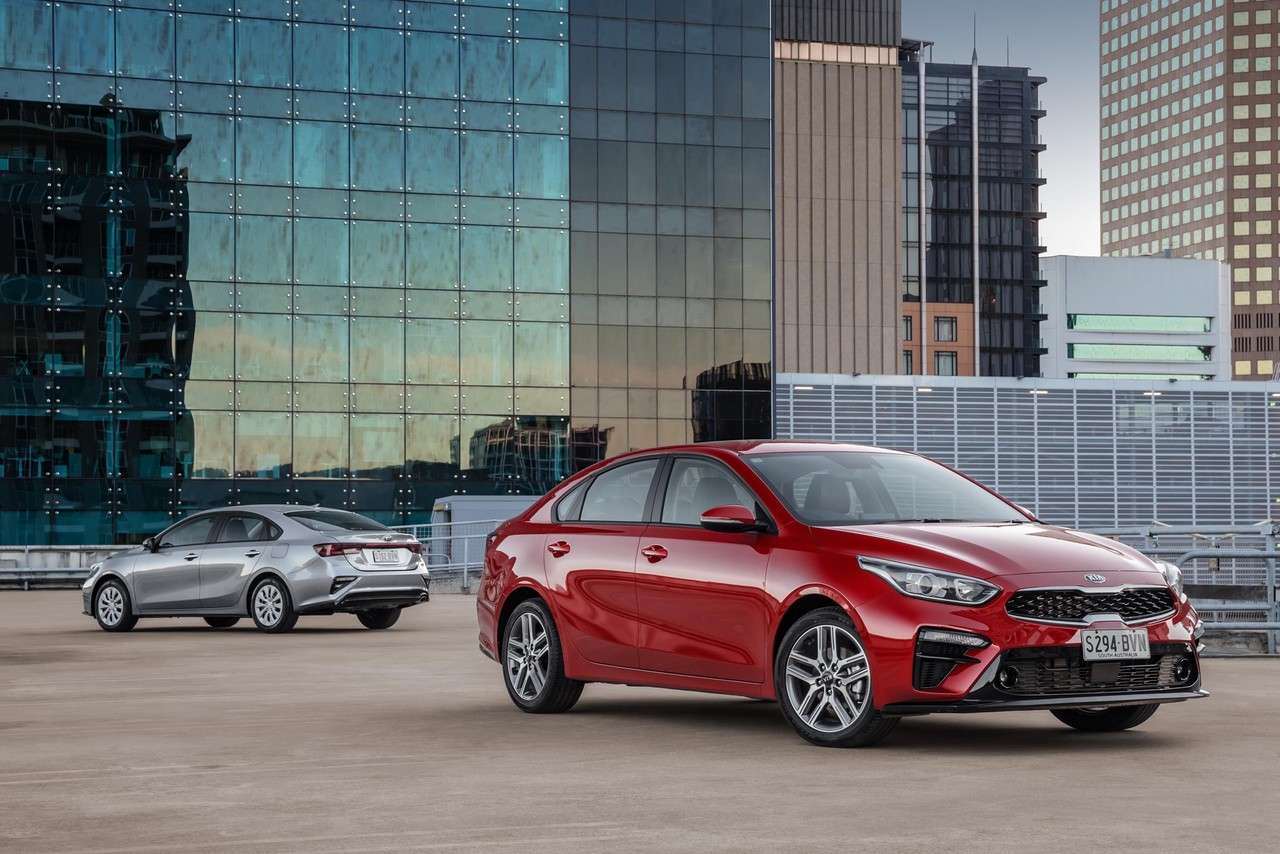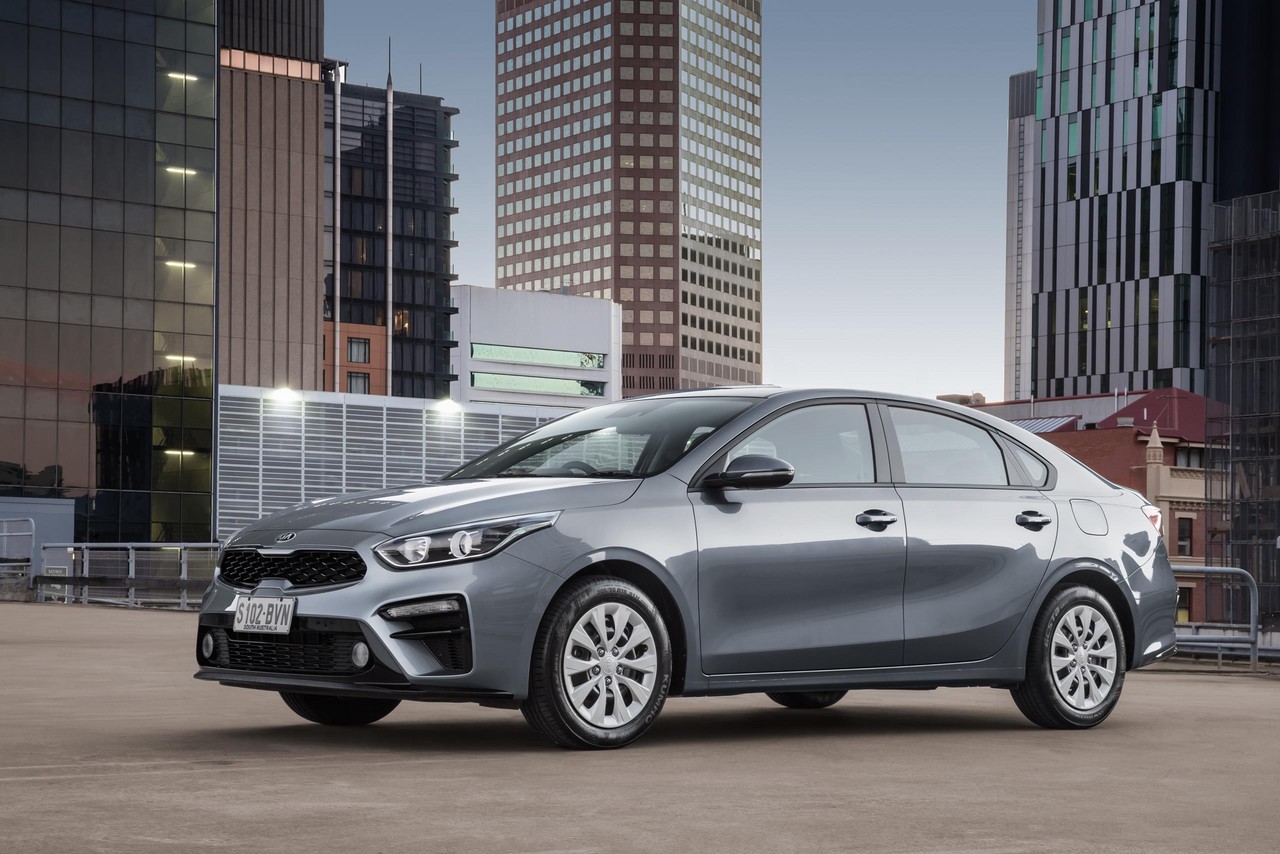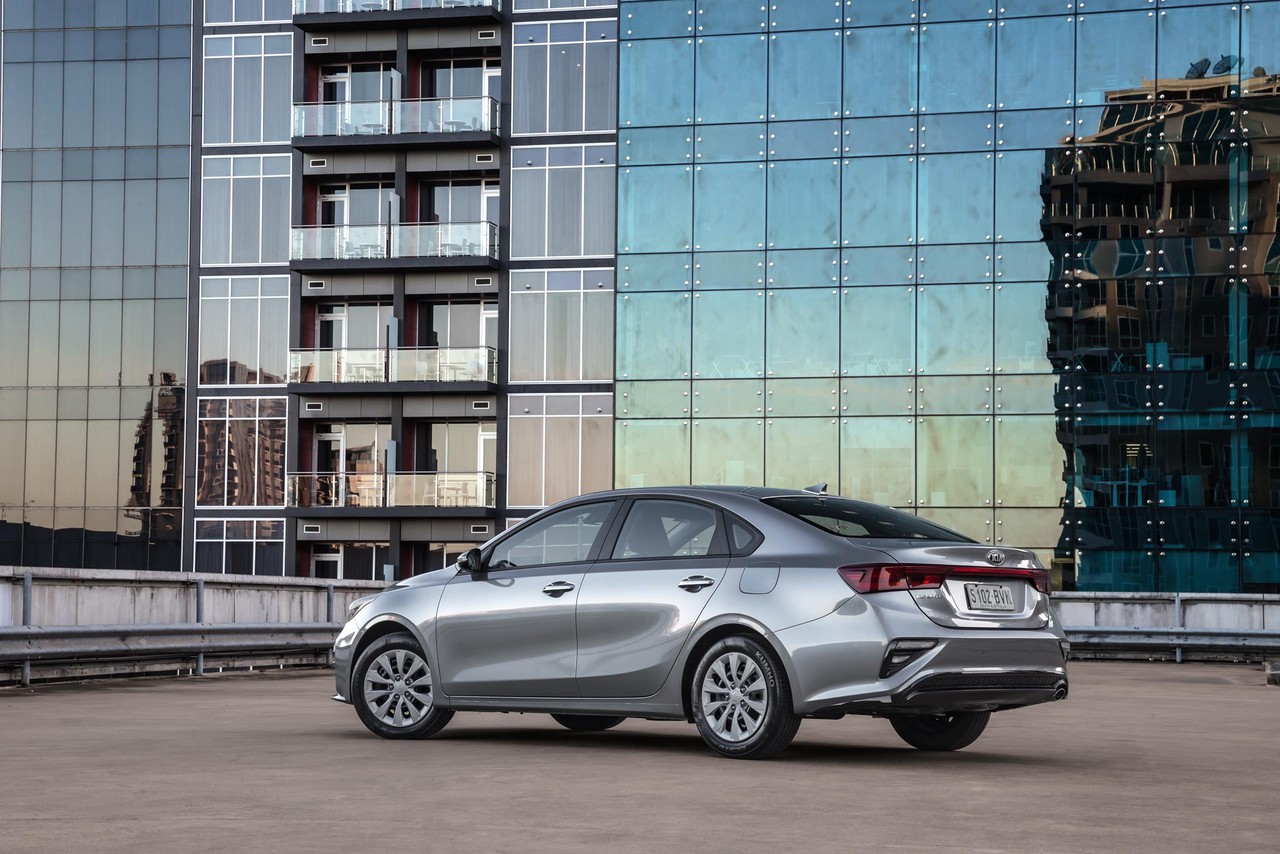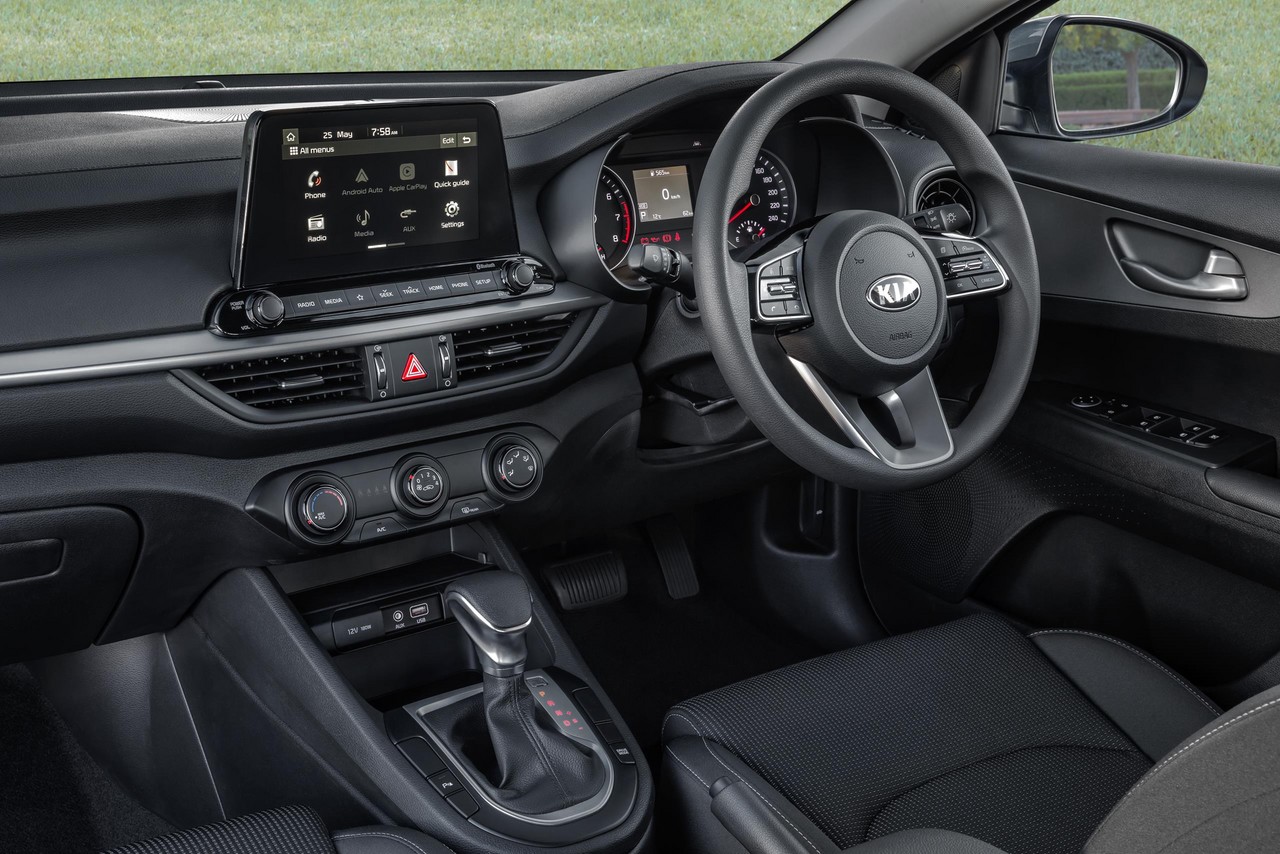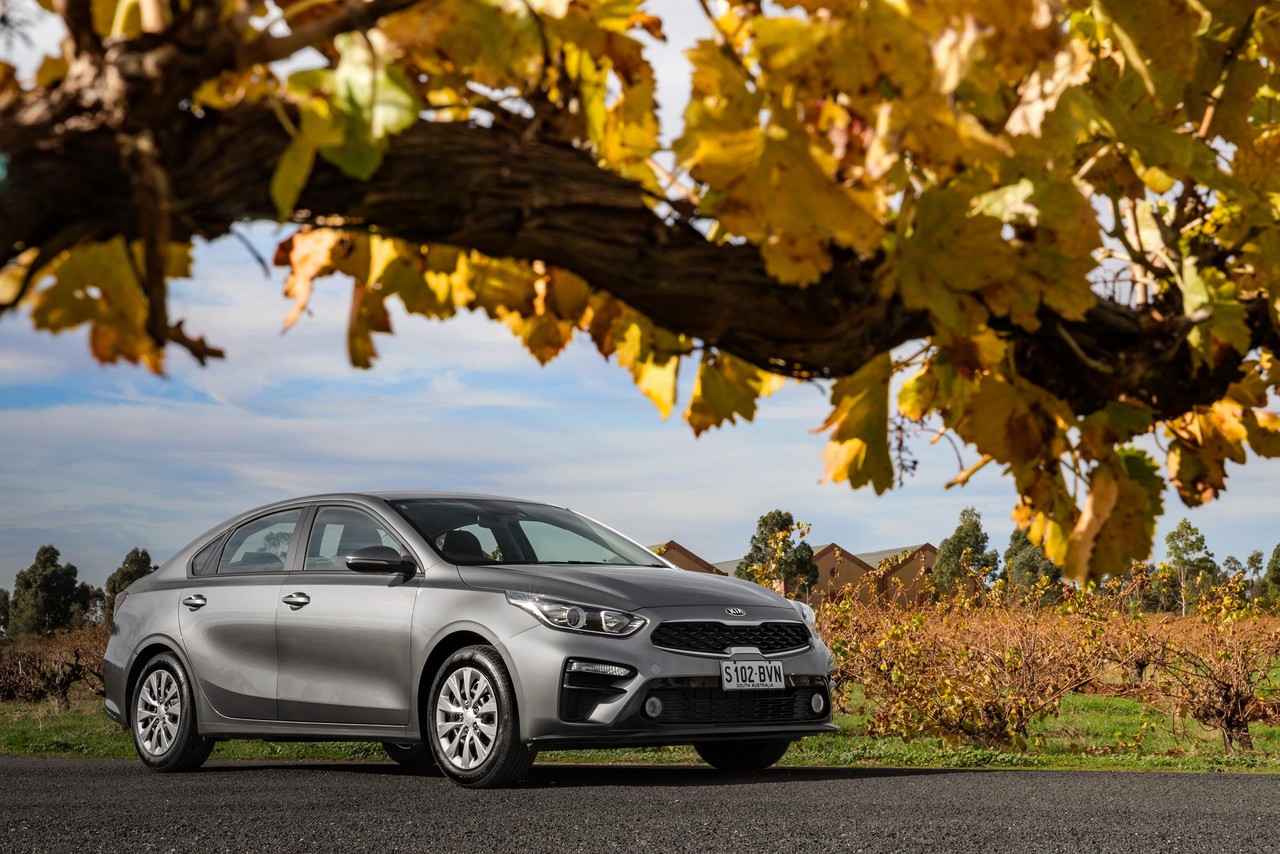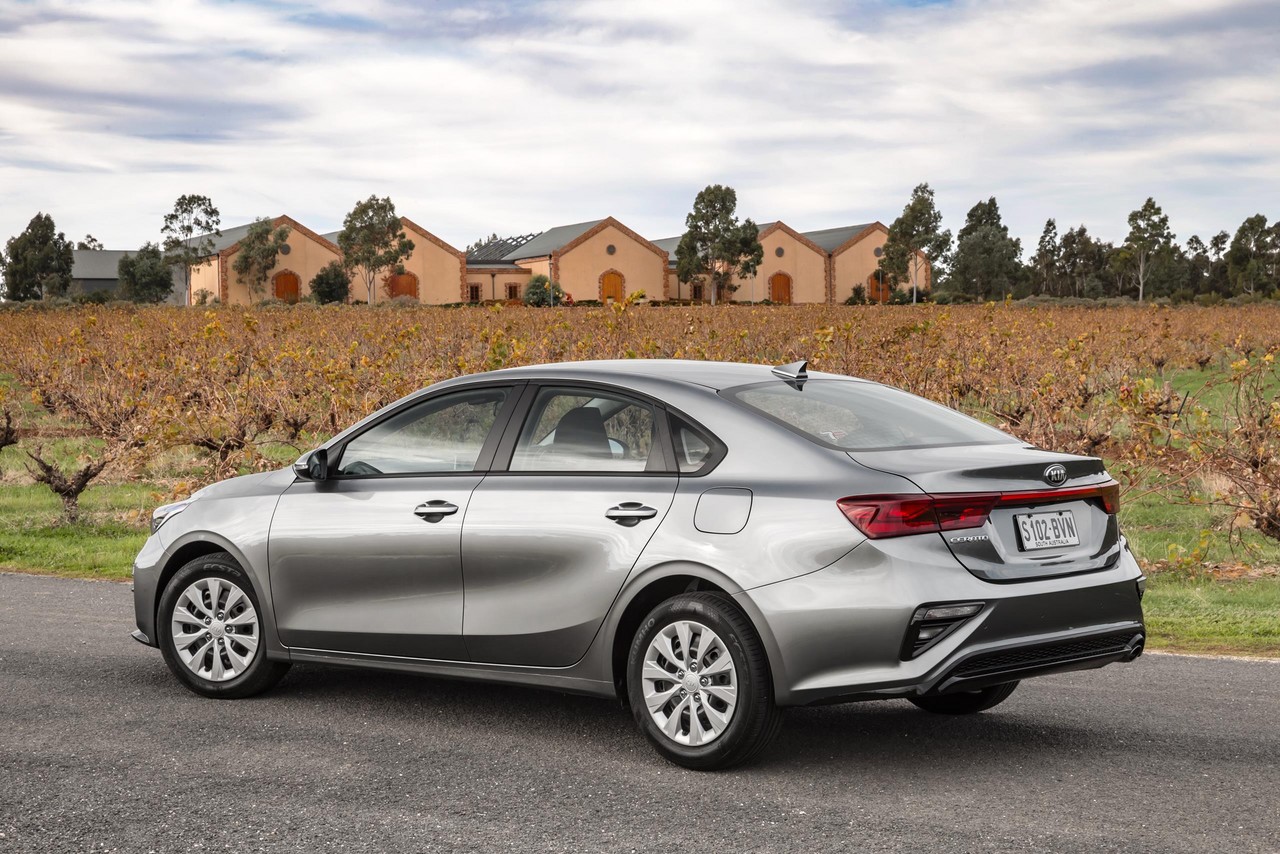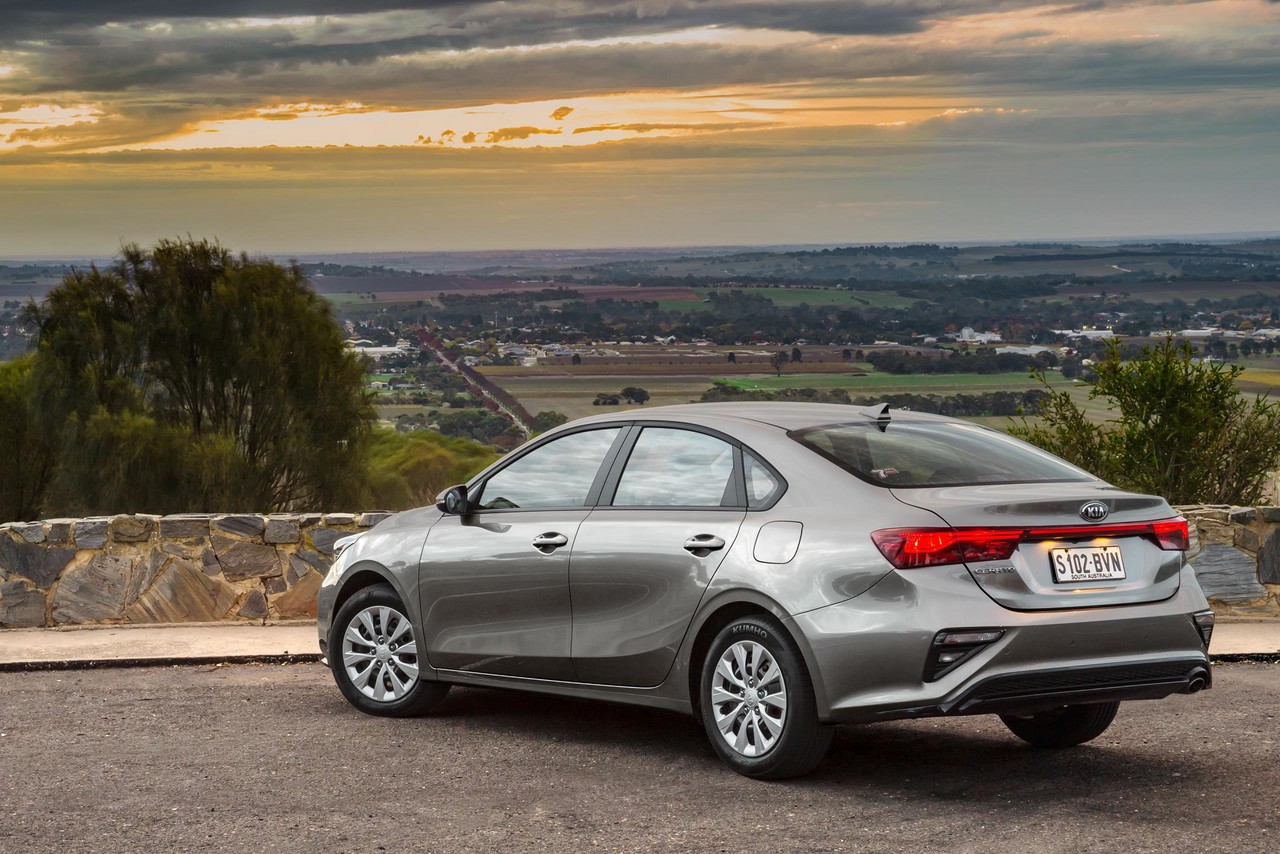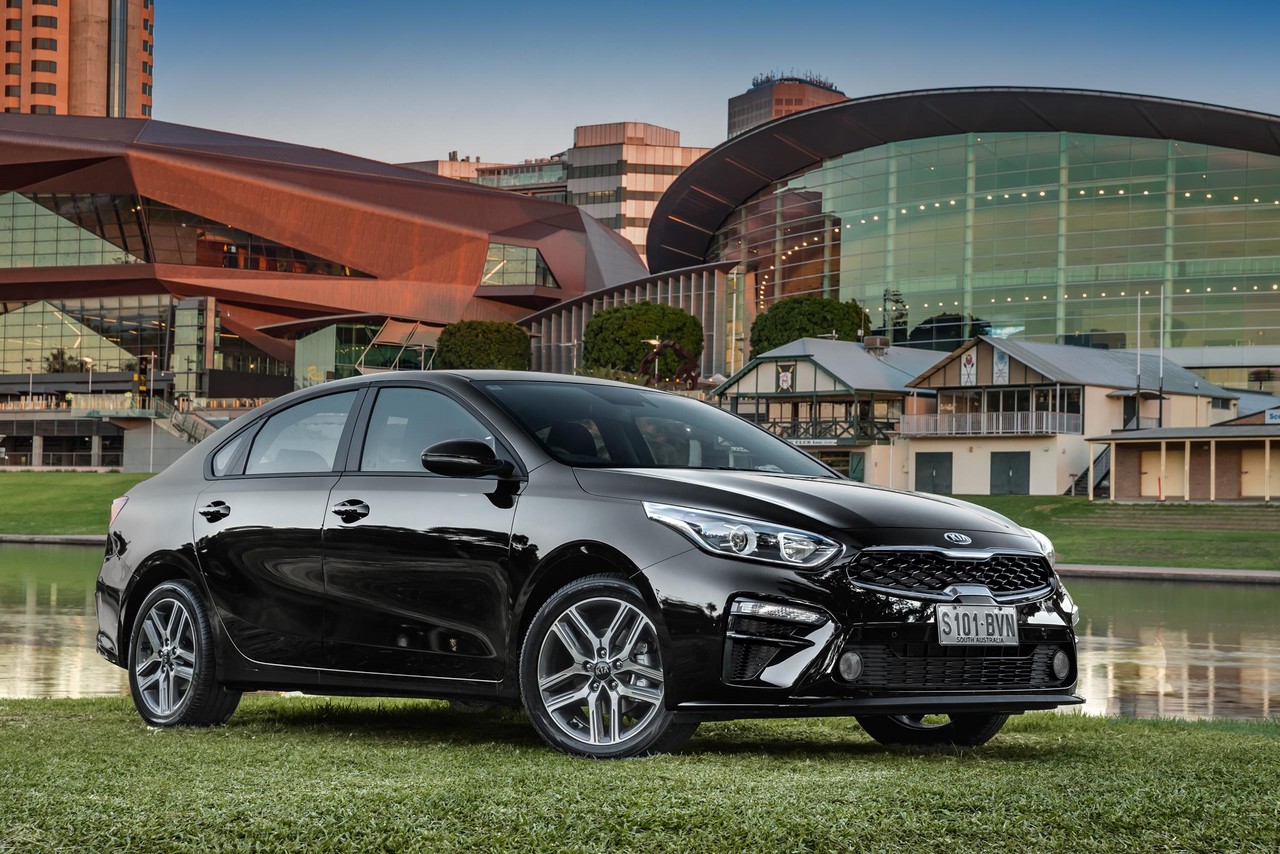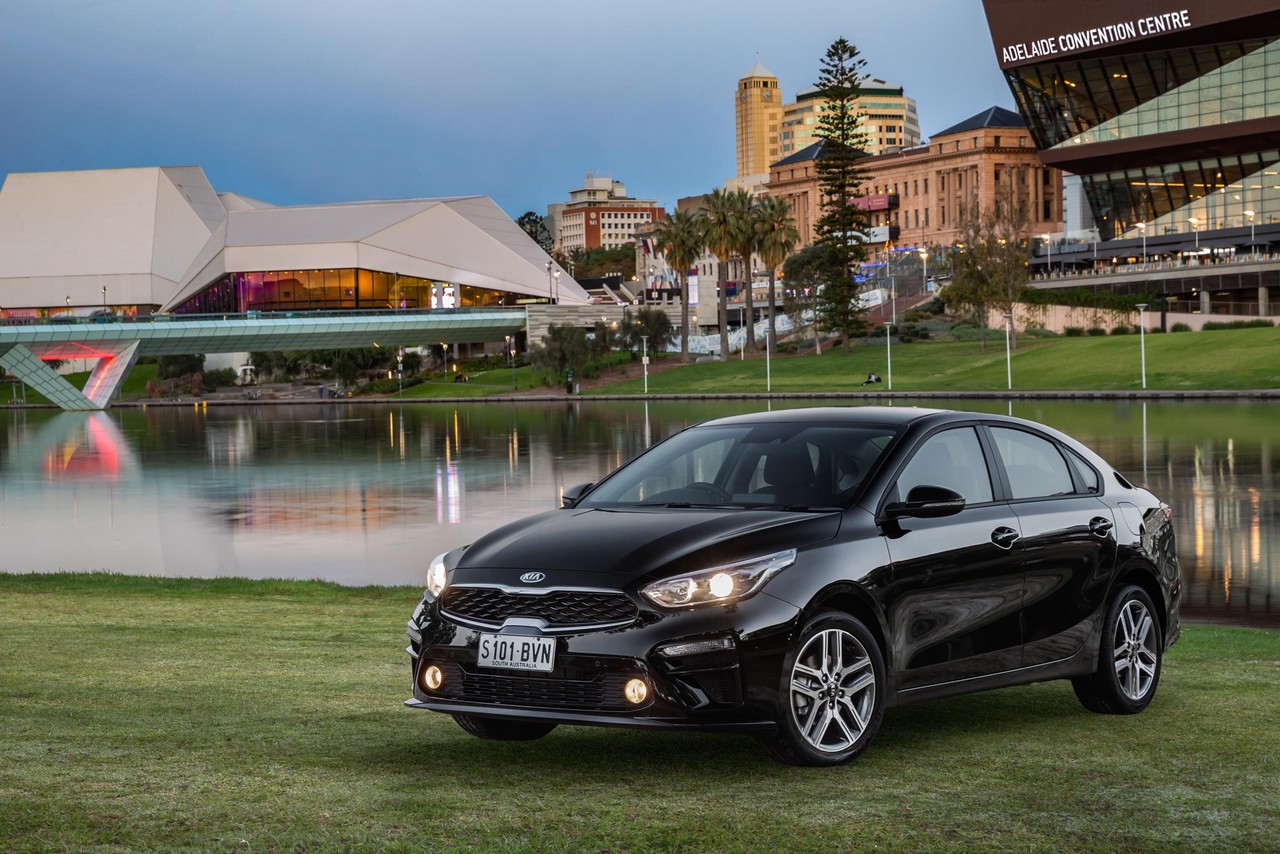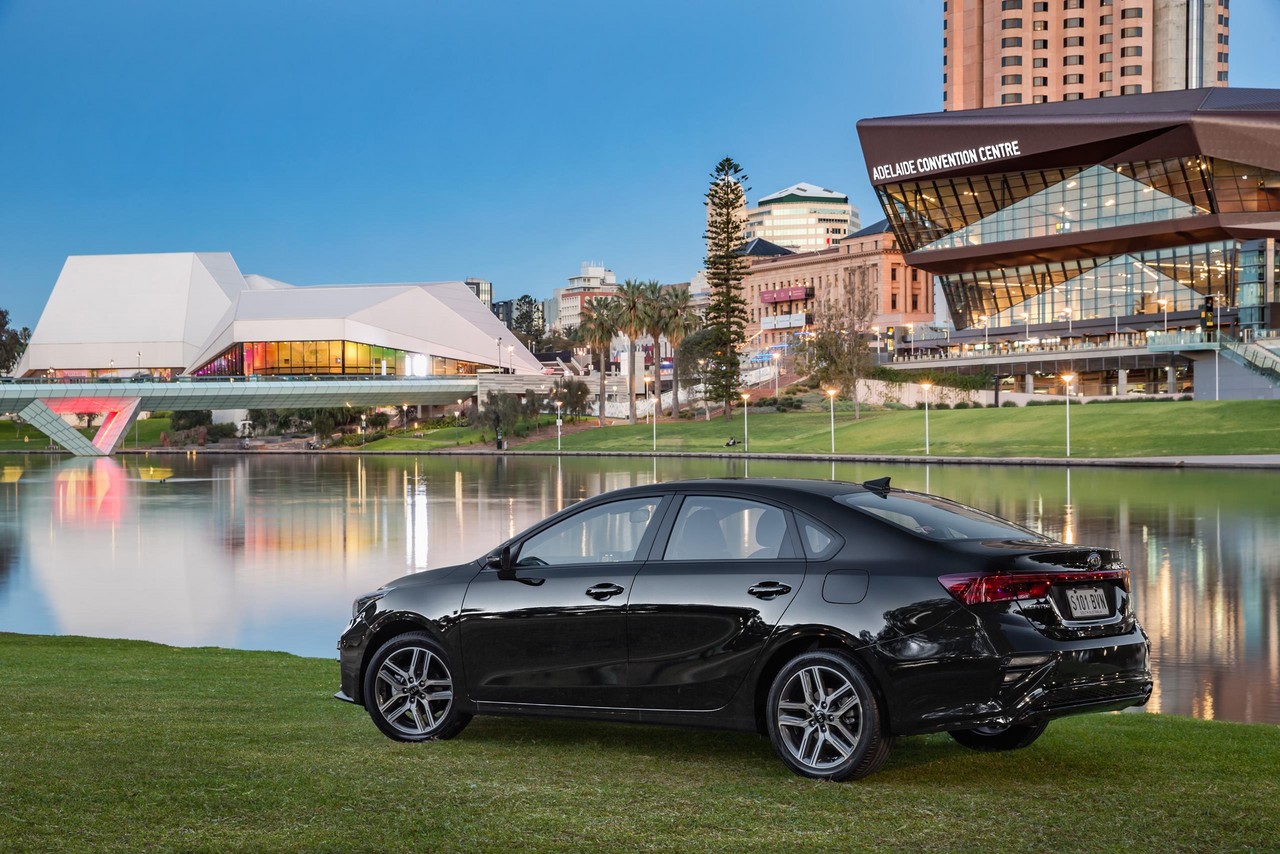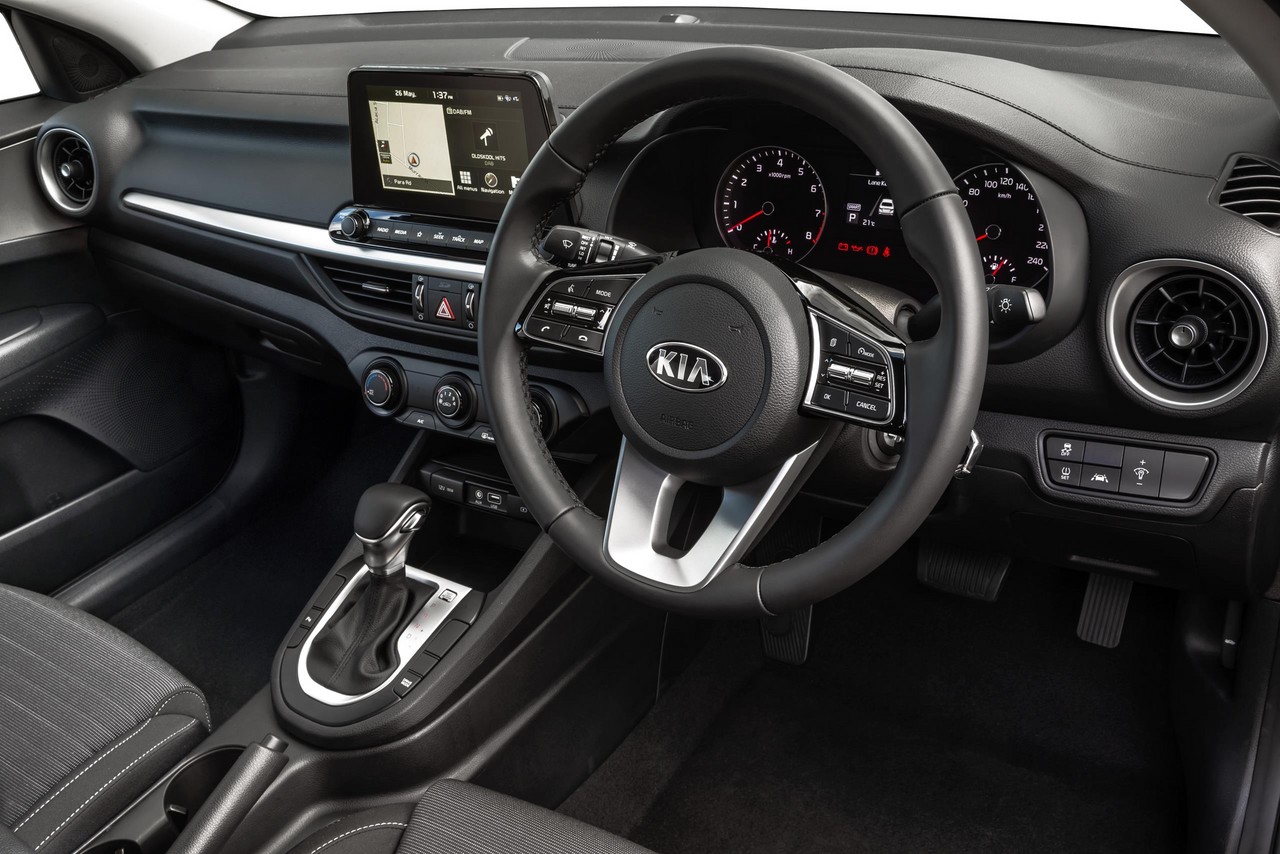
- Autonomous Emergency Braking (AEB) fitted as standard
- Spacious interior and boot
- Light manual gearshift action
- Attractive retail pricing and seven year warranty
- Capable dynamics…
- … but suspension lacks compliance
- Light steering lacks feel
- Road noise and, at higher rpm, engine noise
- Rear seat base too short for adults and raked roofline reduces headroom
- Space-saver spare wheel
- No exterior boot release for Cerato S
Overview
The Kia BD Cerato sedan was released in Australia in June 2018, with hatchbacks following in October 2018. Manufactured at Kia’s Hwaseong Plant in South Korea, the front-wheel drive Kia BD Cerato was initially powered by a 2.0-litre petrol engine that was mated to either six-speed manual or automatic transmissions. As per the table below, the Kia BD Cerato 2.0 MPI range consisted of S, Sport and Sport+ editions.
The Kia Cerato GT – which was powered by a 1.6-litre turbocharged petrol engine mated to a seven-speed double clutch transmission – was released in Australia in January 2019.
2.0 MPI (G4NA) engine
The Kia BD Cerato’s G4NA ‘Nu’ petrol engine had an aluminium alloy block with 81.0 mm bores and a 97.0 mm stroke for a capacity of 1999 cc. Beyond this, the G4NA engine had an aluminium alloy cylinder head, double overhead camshafts, four valves per cylinder, variable intake and exhaust valve timing (D-CVVT), multi-point injection (MPI) and a compression ratio of 10.3:1.
Over the combined ADR 81/02 test cycle, fuel consumption for the Kia BD Cerato sedan was 7.6 litres per 100 km and 7.4 litres per 100 km for models with manual and automatic transmissions, respectively.
| Variant | Engine | Trans. | Peak power | Peak torque |
|---|---|---|---|---|
| S | 1999 cc G4NA petrol I4 | 6sp man., 6sp auto |
112 kW at 6200 rpm | 192 Nm at 4000 rpm |
| Sport, Sport+ |
1999 cc G4NA petrol I4 | 6sp auto | 112 kW at 6200 rpm | 192 Nm at 4000 rpm |
| GT | 1591 cc G4FJ turbo petrol I4 | 7sp DCT | 150 kW at 6000 rpm | 265 Nm at 1500-4500 rpm |
Body and dimensions
Compared to the Kia YD Cerato which it replaced, the BD Cerato sedan was 80 mm longer (at 4640 mm), 20 mm wider (1800 mm) and 5 mm taller (1440 mm), though wheelbase length (2700 mm) was unchanged; boot space was 502 litres (VDA method). Furthermore, the BD Cerato sedan had a drag co-efficient of 0.27 Cd.
Compared to the BD Cerato sedan, the BD Cerato hatch was 130 mm shorter (at 4510 mm) and 5 mm taller (1445 mm), though width and wheelbase length were unchanged. Boot space, however, was 428 litres.
The Kia BD Cerato sedan’s body-in-white was 16 per cent stiffer than its predecessor and this was attributable to:
- The use of Advanced High-Strength Steel (AHSS) for 54 per cent of the bodyshell (compared to 34 per cent for the YD Cerato);
- The use of 105 metres of structural adhesive (five times more than the YD Cerato );
- New hot-stamped steel components to reinforce the lower section of the B-pillar; and,
- A reinforced connecting structure for the roof rail at the top of the B-pillar.
To reduce interior noise, the BD Cerato introduced new soundproofing material around the base of the A-, B- and C-pillars and aluminium engine mounts to reduce engine vibrations.
Suspension
The Kia BD Cerato 2.0 MPI had MacPherson strut front suspension and a torsion beam rear axle. According to Kia,
- New sub-frame designs improved lateral responsiveness;
- New sub-frame bush axle-mounts for the front suspension reduced noise and vibration; and,
- Revised suspension geometry provided ‘a smoother initial response at tip-in’.
For Australian-delivered vehicles, the suspension was ‘optimised’ by Kia Motors Australia’s engineering team which initially tested the BD Cerato at Kia’s Namyang proving ground in South Korea before ‘extensive validation work’ on Australian roads.
The Kia BD Cerato GT, however, had multi-link rear suspension.
Steering
The Kia BD Cerato had rack-and-pinion steering with a column-mounted electric motor for assistance (Kia’s Column-mounted Motor Driven Power Steering, or C-MDPS). Furthermore, the Kia BD Cerato had a minimum turning circle of 10.6 metres.
Safety equipment
Standard safety equipment for the Kia BD Cerato included dual front airbags, front seat-mounted side airbags, full-length curtain airbags (i.e. for front and rear occupants), ABS, electronic brake force distribution, brake assist, electronic stability control, traction control and front seatbelt pre-tensioners.
As standard, the Kia BD Cerato was equipped with –
- Autonomous Emergency Brake (AEB) with Forward Collision Warning (FCW): could monitor the distance to cars in front of the BD Cerato and warn the driver if there was a collision risk. If the driver failed to respond to warning, Autonomous Emergency Braking (AEB) would be initiated to reduce vehicle speed;
- Lane Keep Assist (LKA): monitored the BD Cerato’s position within its lane and provided an audible alerts and steering inputs to maintain the vehicle’s position; and,
- Driver Attention Alert (DAA): monitored driver behaviour and provided visual and audible warnings if signs of fatigue were detected.
Beyond this, the Kia BD Cerato Sport+ was further equipped with –
- ‘AEB Fusion II’ which could detect pedestrians and cyclists for the AEB and FCW systems; and,
- Smart Cruise Control (SCC): could automatically apply the brakes to maintain a pre-set distance between the BD Cerato and the vehicle ahead, accelerate back up to the selected cruising speed when the road was clear and bring the vehicle to rest in congested traffic.
As part of extra-cost option packs, the BD Cerato could also be specified with –
- Blind Spot Detection (BSD): monitored the area up to 70 metres behind the BD Cerato and provided visual warnings in the door mirror when another car entered the driver’s blind spot; and,
- Rear Cross Traffic Alert (RCTA): could detect approaching traffic that may cross the vehicle’s intended path when reversing and warn the driver.
Brakes
The Kia BD Cerato 2.0 MPI had 280 mm by 23 mm ventilated front brake discs and 262 mm by 10 mm solid rear discs. The Kia BD Cerato GT, however, had 305 mm by 25 mm ventilated front brake discs.
Features: Kia Cerato S
The standard infotainment system for the Kia BD Cerato consisted of a six speaker audio system with speed dependent volume control, digital radio tuner (DAB), an eight-inch LCD touchscreen, a 3.5 mm auxiliary input, a USB input, two USB chargers, Bluetooth mobile phone connectivity, and Android Auto and Apple CarPlay smartphone integration with voice recognition.
Beyond this, standard features for the Kia Cerato S included 6.5J x 16-inch steel wheels with 205/55 R16 tyres, charcoal cloth seat trim, a six-way adjustable driver’s seat (including height), air conditioning, cruise control, halogen daytime running lights (DRLs), front and rear parking sensors (with dashboard display), a rear view camera with dynamic parking guidelines, rear fog lights, dusk-sensing headlights, 60:40 split and flat folding rear seats, remote central locking, power adjustable and heated door mirrors, power windows, a height and reach adjustable steering wheel, a 12 volt power socket (front console), a trip computer, an alarm and immobiliser.
For models with automatic transmissions, Kia’s ‘Drive Mode Select’ (DMS) enabled the driver to select from Sport, Eco and Smart modes which varied power steering assistance, throttle response and gearshift behaviour.
Features: Kia Cerato Sport
Compared to the Kia Cerato S, the Cerato Sport was further equipped with satellite navigation with SUNA live traffic information and a ten-year Macpcare subscription, ‘Sport’ patterned cloth seat trim, ‘premium’ steering wheel and gearshift knob, and illuminated vanity mirrors. Visually, the Cerato Sport and Sport+ could be identified by their 7.0J x 17-inch alloy wheels with 225/45 R17 tyres, ‘aero’ blade front wipers and chrome exhaust tips.
Features: Kia Cerato Sport+
The Kia Cerato Sport+ was differentiated by its leather appointed seats, heated front seats, dual-zone climate control air conditioning with automatic defogging, LED daytime running lights (DRLs), proximity key (i.e. keyless entry), power folding door mirrors, an electrochromic rear view mirror, push-button start, illuminated glovebox, passenger-side seatback pocket and ‘smart boot’ which would automatically open the boot when the key was in its proximity for three seconds.
Features: Kia BD Cerato GT
The Kia Cerato GT was distinguished by its 18 x 7.5J alloy wheels with 225/40 ZR18 tyres, eight speaker JBL sound system, sports seats (leather appointed), ventilated front seats, eight-way power adjustable driver’s seat with memory settings, LED headlights with LED rear combination lamp, flat-bottomed steering wheel with perforated leather trim, 4.2-inch ‘Supervision’ instrument cluster display, alloy sports pedals and wireless mobile phone charging pad (Qi standard). Visual cues for the Cerato GT included its unique body kit, high gloss door mirrors and dual exhaust tips.
Specifications
- Specifications: Kia BD Cerato (June 2018)
- Specifications: Kia BD Cerato (October 2018)
- Mechanical and Feature List: Kia BD Cerato (June 2018)
